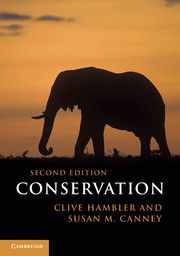Book contents
- Frontmatter
- Contents
- Preface to the Second Edition
- 1 Introduction to conservation
- 2 Threats to biodiversity
- 3 Evaluation of priorities for species and habitats
- 4 Monitoring and Environmental Impact Assessment
- 5 Management of natural and fragmented habitats
- 6 Management of species
- 7 Sustainable use, semi-natural cultural landscapes and the matrix
- 8 Restoration and offsetting
- 9 Environmental policy
- References
- Index to species names
- Index
- Plate section
7 - Sustainable use, semi-natural cultural landscapes and the matrix
Published online by Cambridge University Press: 05 February 2013
- Frontmatter
- Contents
- Preface to the Second Edition
- 1 Introduction to conservation
- 2 Threats to biodiversity
- 3 Evaluation of priorities for species and habitats
- 4 Monitoring and Environmental Impact Assessment
- 5 Management of natural and fragmented habitats
- 6 Management of species
- 7 Sustainable use, semi-natural cultural landscapes and the matrix
- 8 Restoration and offsetting
- 9 Environmental policy
- References
- Index to species names
- Index
- Plate section
Summary
How do we determine whether our exploitation of the natural world is sustainable? How does use relate to conservation? How might such considerations help reduce our ecological impact outside ‘natural’ or ‘near-natural’ areas? This chapter examines the controversial issues of sustainable management of species and habitats.
Sustainability has been defined in a variety of ways. The current concept of sustainability owes much to the World Commission on Sustainable Development, who defined sustainable development in The Brundtland Report of 1987 as ‘development that meets the needs of the present without compromising the ability of future generations to meet their own needs’. Sustainable development has been defined in a variety of other ways, but generally it contains two key concepts: the cultural idea of human needs and the recognition of ecological limits informed by science. This chapter focuses on the ecological aspects, while the cultural component is discussed in Chapter 9.
Management can ensure harvesting levels of a species that maintain yield in the long term, and indeed sustainability has been considered for many years by resource managers such as foresters and fisheries officers. However, this yield is often achieved at a risk to overall conservation. Similarly, habitats have been managed by traditional methods to achieve longterm use of many natural resources, but the degree to which they deliver conservation goals is variable and dependent on context. The ‘semi-natural habitats’ created by traditional use will rarely be as valuable overall for conservation as a natural habitat (although they may be more valuable for a particular aspect such as a species or landscape deemed particularly attractive). However, semi-natural habitats will generally be more valuable than areas subjected to industrial scale land uses such as intensive agriculture.
- Type
- Chapter
- Information
- Conservation , pp. 237 - 270Publisher: Cambridge University PressPrint publication year: 2013



